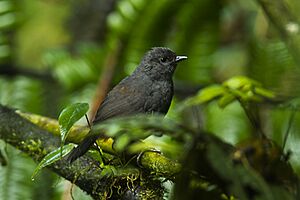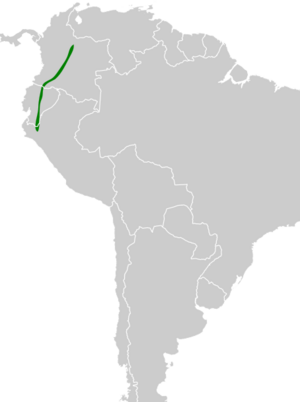Long-tailed tapaculo facts for kids
Quick facts for kids Long-tailed tapaculo |
|
|---|---|
 |
|
| Conservation status | |
| Scientific classification | |
| Genus: |
Scytalopus
|
| Species: |
micropterus
|
 |
|
The long-tailed tapaculo (Scytalopus micropterus) is a small, shy bird. It belongs to a group of birds called Rhinocryptidae, also known as tapaculos. These birds are often hard to spot because they live in dense forests. You can find the long-tailed tapaculo in the eastern Andes mountains. This includes parts of Colombia, Ecuador, and northern Peru.
Contents
About This Bird
The long-tailed tapaculo was once thought to be the same as another bird, the rufous-vented tapaculo. But scientists listened closely to their songs. They found that the long-tailed tapaculo sings differently. Because of these unique songs, it is now considered its own special species.
What It Looks Like
The long-tailed tapaculo is one of the bigger tapaculo birds. It is about 13.5 centimeters (5.3 inches) long. Its tail is also quite long compared to other birds in its group.
Male long-tailed tapaculos weigh around 27 to 32.5 grams (about 1 ounce). Their feathers are mostly dark gray. They have rusty brown feathers on their sides, with some black stripes. Female birds look similar but are a bit duller in color.
Its Song
This bird's song usually starts with single notes. Then, it quickly changes into a series of pairs of notes. It sounds a bit like "chip-chip, chip-chip." When it senses danger, its alarm call is a series of notes that go down in pitch. You can listen to its song online here.
Where It Lives
The long-tailed tapaculo lives on the eastern slopes of the Andes mountains. Its home stretches from Colombia all the way south to northern Peru.
It likes to live in wet, bushy areas. You can often find it near streams or at the edges of forests. In most places, it lives at heights between 1,250 and 2,300 meters (about 4,100 to 7,500 feet) above sea level. In Peru, it prefers slightly higher spots, from 1,650 to 1,950 meters (about 5,400 to 6,400 feet).
Behavior
What It Eats
Like other tapaculos that live in cloud forests, the long-tailed tapaculo searches for food on or near the ground. It mainly eats small invertebrates, which are tiny creatures without backbones, like insects.
Reproduction
Scientists believe that the long-tailed tapaculo might lay eggs all year round. Some birds found in September and November had signs they were ready to breed. However, not much more is known about how they raise their young.
Conservation Status
The IUCN (International Union for Conservation of Nature) keeps track of animals around the world. They have listed the long-tailed tapaculo as a species of "Least Concern." This means they are not currently worried about it becoming endangered. Even though it lives in a somewhat small area, its population is believed to be large enough to be stable.


